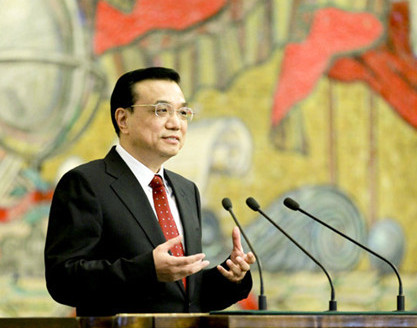
The current Chinese government's economic policy framework can be summarized as no stimulus measures, de-leveraging and structural reform. [File photo]
The current Chinese government's economic policy framework has become a hot topic for discussion. It can be summarized as no stimulus measures, de-leveraging and structural reform.
|
|
|
The current Chinese government's economic policy framework can be summarized as no stimulus measures, de-leveraging and structural reform. [File photo] |
The new government is focusing on market self-regulation, stepping up supervision and loosening market interference. As for growth issues, Premier Li Keqiang has reiterated that economic growth will not be slower than a prescribed lower limit and inflation will not surpass an upper limit.
China's official news agency Xinhua reported that the "bottom line" for economic growth this year is 7 percent, but the "lower limit" is 7.5 percent. It was predicted that China would slow its economic growth to around 7 percent in the future.
Based on this thinking, it is almost certain that China will follow the economic growth objective stipulated in its Twelfth Five-Year Plan (2011-15) more strictly by refraining from seeking excessive growth, because that would inevitably cause inflation. In the meantime, the government can neither afford an economic hard landing.
Another index worthy of note is the unemployment rate. When unemployment rises, an economic stimulus is often necessary, however the government's recent attitude is that 7 percent growth is sufficient.
The government has to find a way to balance economic growth, inflation and the unemployment rate. This will be achieved through structural reform, aimed at industrial upgrades and rebalancing, people-oriented urbanization and more effective financial policies.
Recent measures show that China is limiting high-energy consuming industries and promoting the information technology sector. The National Development and Reform Commission (NDRC) also said it would downsize production in 11 industries, including steel, aluminum and cement.
Meanwhile, the government's people-oriented urbanization policy stresses restoring the urban social security system, and removing barriers in medium-and-small city household registrations. The focus on the transport infrastructure means that new high-speed railways and city metros will be given higher priority. More importantly, the central government has started reassessing the decade-long one child policy, and is expected to allow parents who are both the only child in their family to have more than one child.
These financial policies safeguard industrialization and urbanization. In all the detailed measures, eliminating extravagance and reducing public spending show the government's flexibility. Austerity measures affect investment to some extent, but they improve cost-efficiency in local government at all levels.
In addition, reforms on tax policies and local government bond issuing mechanisms serve the same purposes.
Although China's economic policy shift is straightforward, the market still fails to understand it. "Using new capital well and liquidizing existing assets" is the government's focus, however the market has not recognized the policy's deeper implications and is therefore unable to forecast its impact.
After the money squeeze in June, market liquidity did not improve significantly. The market widely believes that "liquidizing existing assets" means that a prudent increase in money supply (M2) is China's principal monetary policy goal.
But China's M2 increase is still around 14 percent, higher than the annual target of 13 percent, which means it is unlikely that China's monetary policy will be loosened.
This raises the question of how China can ensure 7.5 percent growth while implementing a tight monetary policy.
China's deleveraging policy is also highly targeted. The government has reiterated that the true goal of its monetary policy is to solve the problem of shadow banking, inject liquidity into the real economy and support small businesses. But this once again puts financial institutions in limbo, because a tight monetary policy may cause new liquidity shortages, which would in turn cause an economic hard landing.
It is fair to say the new administration's economic policy still needs to stand the test of time, and fears of low economic performance remain. This is why I think the Chinese government should consider lowering interest rates, in order to ensure stable growth, which is a precondition for structural reform.
The author is the Chief Economist at ANZ's Greater China.
This article was translated by Chen Boyuan. Its original unabridged version was published in Chinese.
Opinion articles reflect the views of their authors, not necessarily those of China.org.cn.